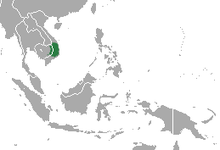| Black-shanked douc[1] | |
|---|---|

| |
| Black-shanked douc with baby at Cát Tiên National Park | |
| Scientific classification | |
| Domain: | Eukaryota |
| Kingdom: | Animalia |
| Phylum: | Chordata |
| Class: | Mammalia |
| Order: | Primates |
| Suborder: | Haplorhini |
| Infraorder: | Simiiformes |
| Family: | Cercopithecidae |
| Genus: | Pygathrix |
| Species: | P. nigripes
|
| Binomial name | |
| Pygathrix nigripes A. Milne-Edwards, 1871
| |

| |
| Black-shanked douc range | |
The black-shanked douc (Pygathrix nigripes) is an endangered species of douc found mostly in the forests of Eastern Cambodia, with some smaller populations in Southern Vietnam. The region they are mostly found in is called the Annamite Range, a mountainous area that passes through Cambodia and Vietnam. Its habitat is mostly characterized by evergreen forest in the mountains, in the middle to upper canopy. They move around quadrupedally and by brachiation up in the trees. This species is unique with its coloration among the doucs as it has a bluish face with yellow rings around its eyes a blue scrotum and a pink penis. Like other doucs, this species has a tail as long as its body and head length. Black-shanked douc have been observed in groups ranging from 3 to 30 individuals, depending on their habitat. Group tend to have a fission-fusion dynamic that changes with food availability. Their diet varies from dry to wet season. Regardless of the season, their diet consists mostly of leaves, but they have also been found to consume considerable amounts of fruits and flowers during wet season. The species changed conservation status in 2015 from endangered to critically endangered in the IUCN Red List of Endangered Species. This reassessment is due to an increase of the rate of population decline. No global population estimate exists.[4] The majority of the population can be found in Cambodia, with smaller populations in Vietnam. In fact, the Wildlife Conservation Society reports almost 25,000 individuals in Cambodia's Keo Seima Wildlife Sanctuary, a population that has remained stable over the last decade.[5][6] The largest populations estimated to be in Vietnam is around 500-600 individuals.[4] The biggest challenges that the black-shanked douc faces in terms of conservation are habitat loss and illegal poaching. Conservation efforts are being made to control illegal poaching and trade in Vietnam by putting laws against hunting and trading threatened species.

- ^ Groves, C. P. (2005). Wilson, D. E.; Reeder, D. M. (eds.). Mammal Species of the World: A Taxonomic and Geographic Reference (3rd ed.). Baltimore: Johns Hopkins University Press. p. 173. ISBN 0-801-88221-4. OCLC 62265494.
- ^ Duc, H.; Quyet, L.K.; Rawson, B.M.; O'Brien, J.; Covert, H. (2021). "Pygathrix nigripes". IUCN Red List of Threatened Species. 2021: e.T39828A196138291. doi:10.2305/IUCN.UK.2021-1.RLTS.T39828A196138291.en. Retrieved 19 November 2021.
- ^ "Appendices | CITES". cites.org. Retrieved 2022-01-14.
- ^ a b Unexpected Large Monkey Population Discovered Archived 2011-10-04 at the Wayback Machine Newswise, Retrieved on August 28, 2008.
- ^ Nuttall, Matthew N.; Griffin, Olly; Fewster, Rachel M.; McGowan, Philip J. K.; Abernethy, Katharine; O'Kelly, Hannah; Nut, Menghor; Sot, Vandoeun; Bunnefeld, Nils (2021). "Long-term monitoring of wildlife populations for protected area management in Southeast Asia". Conservation Science and Practice. 4 (2): e614. doi:10.1111/csp2.614. hdl:1893/33780. ISSN 2578-4854. S2CID 245405123.
- ^ Griffin, O.; Nuttall, M. (2020-12-04). "Status of Key Species in Keo Seima Wildlife Sanctuary 2010-2020". Wildlife Conservation Society. doi:10.19121/2020.Report.38511. S2CID 229677607.
